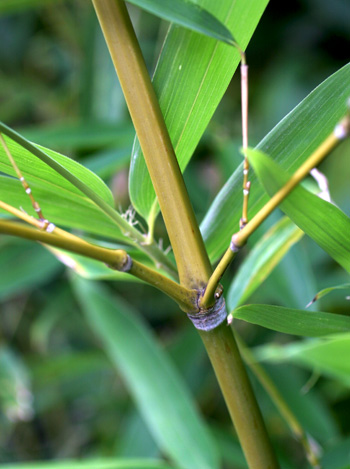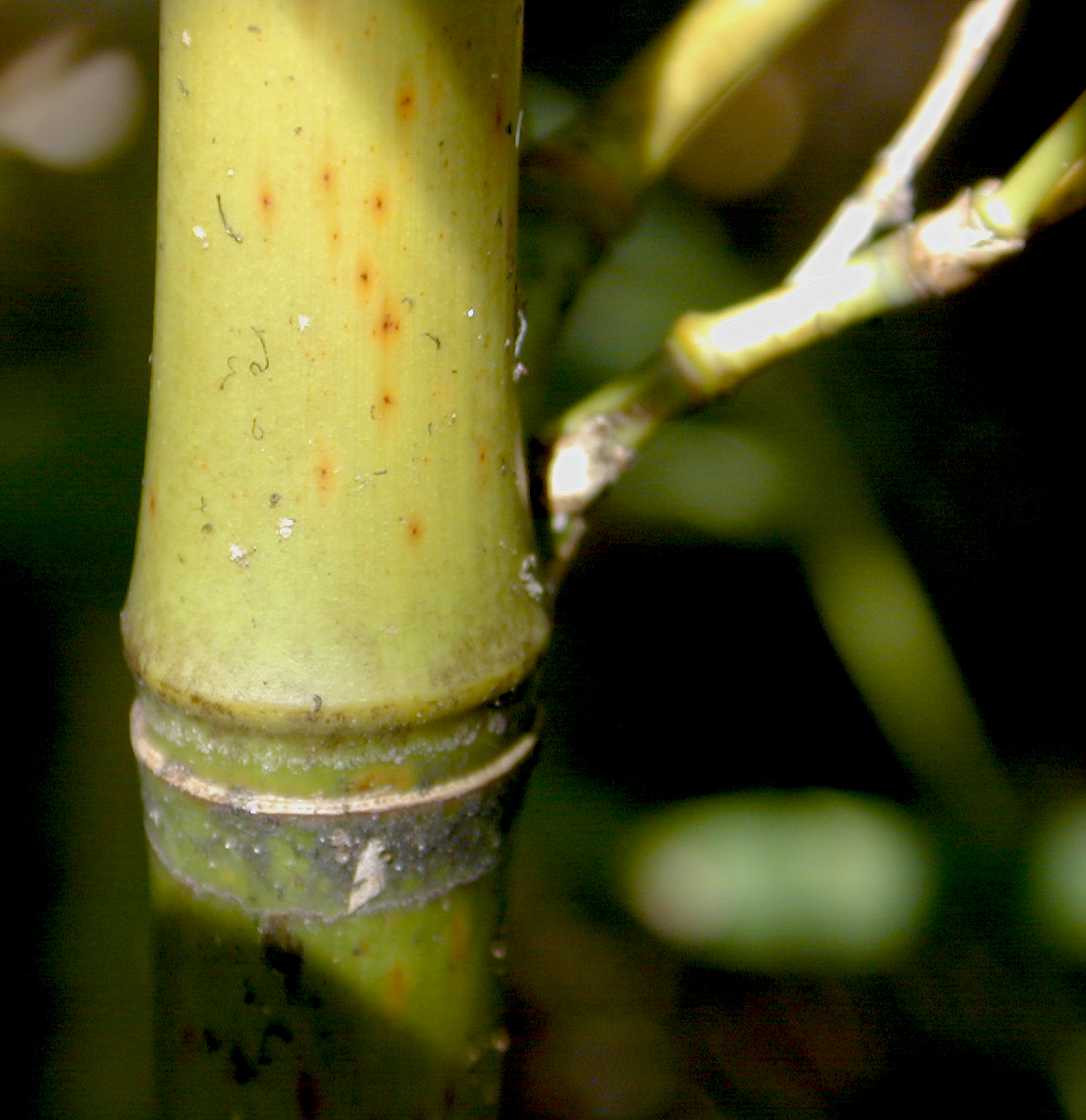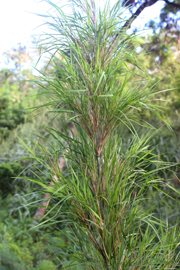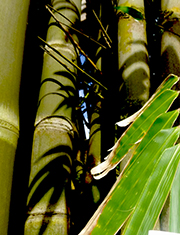|
Key to Subfamily Bambusoideae
|
|

|
|
Bamboos are certainly distinctive as grasses; few would mistake these plants for any other grass. However, they can be difficult to distinguish. Bamboo species look generally similar and either flower rarely or not at all in Hawai‘i. Planted bamboos can be persistent in an area, leading one to assume a naturalized status for an old ornamental planting. Only three species are thought to be naturalized in Hawai‘i, and "common" bamboo is not included as one of these. Wagner, Herbst, & Sohmer (1990) treat only two species as naturalized. One (‘ohe Hawai‘i) may be indigenous, but is more likely an early Polynesian introduction. Stone (1970) lists four species of bamboo from Guam; Raulerson (1996) lists at least seven; all are introduced, clumping species, except for an unidentified species of Phyllostachys. See the bottom of this page for a list of the many rare bamboo species not covered by our key.
The following key is based entirely on vegetative characteristics, which can be somewhat variable in some species and between wild and cultivated individuals of the same species. We caution against relying on the characteristic below of "[E]ach node with two rings". Many culms of many species appear to have two rings at each node, depending upon how one defines a ring. The common wild bamboo in Hawai‘i, Schizostachyum glaucifolium, has a narrow, deep groove at each node, separating two prominent "rings". However, this is one ring.
|
|
|
|
[BAMBOOS]
|
|
|
|
|
24a
|
( 10 & 10 &  15) 15) |
 Culm (stem) with a distinct flattening on one side extending well above where branches emerge above nodes and thus 'D'-shaped in cross-section. Usually two branches(sometime a weak third) arising at each node. { Running bamboos, spreading by underground rhizomes, new culms arising a few feet apart from old culms and eventually forming expansive thickets .. .
Culm (stem) with a distinct flattening on one side extending well above where branches emerge above nodes and thus 'D'-shaped in cross-section. Usually two branches(sometime a weak third) arising at each node. { Running bamboos, spreading by underground rhizomes, new culms arising a few feet apart from old culms and eventually forming expansive thickets .. .
Figure 3B. Note flattened face on culm above branches
on this Phyllostachys bamboo.
|
|
[25]
|
|
24b
|
|
Culm without a distinct flattening on one side above the nodes, round in cross-section. Usually three or more small branches emerging at a node. Sheath blade (part at tip of sheath; see Fig.s 3F & 3I) broad, length less than 2X width. { Clumping bamboos (forming dense clumps that spread slowly outward), new culms arising close to old culms .. .
|
|
[27]
|
|
~~~~ ~~~~~~~~~~~~~~~~~~~~~~~~~
|
|
|
25a
|
(24) |

Joints (nodes) prominent, main (lower) ring at node fringed with dense purplish or (if faded) brownish hairs (Fig. 3C). { Tree-like, stiff erect culms to 8 m (25 ft) in height; culms green, olive, yellow, black, or purple—or green with black markings .. .
Figure 3C. Fringe of purple hairs at node are distinctive of new growth of Phyllostachys nigra.
|
|
[26] |
|
25b
|
|
Joints prominent, but without dense hairs; usually a whitish, waxy band below node (see Fig. 3B). Shrubby, culms arching, rising between 4 and 15 feet (1 to 5 m); culms, green to yellow. Dwarf bamboo, golden bamboo. [HAW - NAT ORN]
Phyllostachys aurea A. & C. Rivière
|
|
|
~~~~ ~~~~~~~~~~~~~~~~~~~~~~~~~
|
|
|
26a
|
(25) |
{ Culms green, typically forming open (in places very extensive) stands with erect culms evenly spaced at 1 to 2 m (3-6 ft) apart (Fig. 3C). Henon bamboo [HAW - NAT] [FACU]Phyllostachys nigra var. henionis (Mitf.) Rendele
|
|
|
26b
|
|
{ Culms black or with black markings. Black bamboo [HAW - ORN] [FACU]Phyllostachys nigra var. nigra (Lodd. ex Lindley) Munro
|
|
|
~~~~ ~~~~~~~~~~~~~~~~~~~~~~~~~
|
|
|
27a
|
(24) |
Leaves linear, about 1/8 inch wide (see Fig. 3H, below). Culm walls thick, center opening tiny. { Weeping bamboo [HAW - ORN]Otatea acuminata (Munro) C. E. Smith
|
|
|
27b
|
|
Leaves lance-shaped, 1/4 to over 1 inch wide (see Fig. 1B). Culm walls thick or thin, but center opening usually large .. .
|
|
[28] |
|
~~~~ ~~~~~~~~~~~~~~~~~~~~~~~~~
|
|
|
28a
|
(27) |
Base of culms with stout spines and culm branches with stiff spines at nodes. Spiny bamboo, pio titoca, tituka, piao lahe [GUM - ORN]
Bambusa blumeana Schult. & Schult. f.
|
|
|
|
28b
|
|
Plant without conspicuous basal spines or spines on branches .. .
|
| [29] |
|
~~~~ ~~~~~~~~~~~~~~~~~~~~~~~~~
|
|
|
29a
|
(28) |
 Each node with two rings, main one (sheath scar) below and second one above at base of branches, this upper ring sometimes only a swelling around culm or absent in large, mature culms. Usually three prominent side branches at a node, but can be many. Genus Bambusa
Each node with two rings, main one (sheath scar) below and second one above at base of branches, this upper ring sometimes only a swelling around culm or absent in large, mature culms. Usually three prominent side branches at a node, but can be many. Genus Bambusa
Figure 3D. Node of a Bambusa showing a swollen area (upper ring) supporting three side branches (only two visible) and a conspicuous sheath scar ring below. .. .
|
| [30] |
|
29b
|
|
Culm with one ring-like scar at each node. Several to many, subequal side branches emerge at each node. Culms green, up to 2.5 inches (6 cm) wide at base. { A large clumping bamboo, forming expansive stands in wet areas. ‘Ohe Hawai‘i, "native" bamboo [HAW - POL?] [FAC] Schizostachyum glaucifolium (Rupr.) Munro
|
|
|
~~~~ ~~~~~~~~~~~~~~~~~~~~~~~~~
|
|
|
30a
|
(29) |
Stems swollen or expanded between nodes. Rare nursery plant. Buddah bamboo [HAW - ORN]
Bambusa ventricosa McClure
|
|
|
30b
|
|
Stems NOT swollen or expanded between nodes
|
|
[31] |
|
~~~~ ~~~~~~~~~~~~~~~~~~~~~~~~~
|
|
|
31a
|
(30) |
 Culm sheath broadly triangular to 12 in (30 cm) tall, hairy with loose black hairs. Culms up to 5 inches (13 cm) in diameter at base, var. vittata golden yellow with (typically) distinctive dark green vertical stripes (the common variety grown in in Hawai‘i), or culms all green in var. vulgaris (see Figs. 3E, 3F, and 3I). { A very large, clumping bamboo, common on Guam. Golden bamboo, common bamboo [HAW - ORN] [FAC], piao palaoan [GUM - ?NAT]
Culm sheath broadly triangular to 12 in (30 cm) tall, hairy with loose black hairs. Culms up to 5 inches (13 cm) in diameter at base, var. vittata golden yellow with (typically) distinctive dark green vertical stripes (the common variety grown in in Hawai‘i), or culms all green in var. vulgaris (see Figs. 3E, 3F, and 3I). { A very large, clumping bamboo, common on Guam. Golden bamboo, common bamboo [HAW - ORN] [FAC], piao palaoan [GUM - ?NAT]Bambusa vulgaris J.C. Wendl.
Figure 3E. Distinctive large stem of Bambusa vulgaris var. vittata.
Note double ring at node NOT apparent in these large stems.
|
|
|
31b
|
|
Culms less than 2 inches (5 cm) in diameter. Leaves whitish on undersides. { Plant shrubby, culms to 15 feet (5 m), often arching. Dwarf bamboo, hedge bamboo [HAW - ORN], [GUM - ORN]
Bambusa multiplex (Lour.) J.A. & J.H. Schultes
|
|
|
|
|
Clayton and Snow (2010) note that perhaps some two dozen bamboos are in cultivation on Pacific Islands. Staples and Herbst (2005) cover 7 species as likely to be found in Hawaiian gardens, all of which are included in our key above. Species of bamboo not included in the key that might be found growing in botanical and private gardens in Hawai‘i (mahalo to F. & K. Starr; Rauch & Weissich, 2000; Clayton & Snow, 2010) [ORN]:
Bambusa arundinacea (Retz.) Willd.
Bambusa balcooa Roxb.
Bambusa beecheyana Munro>
Bambusa glaucophylla Widjaja – dwarf Malay bamboo
Bambusa lako Widjaja – Timor black bamboo
Bambusa malingensis McClure – Maling bamboo
Bambusa oldhamii Munro – Oldham's bamboo, giant timber bamboo
Bambusa textilis McClure – Weaver's bamboo
Bambusa tuldoides Munro
Bambusa vulgaris 'Wamin' Brandis ex McClure – Wamin bamboo
Chusquea coronalis Söderst & Calderón– Costa Rican weeping bamboo
Dendrocalamus asper (Schult.) Backer – giant bamboo
Dendrocalamus brandesii (Munro) Kurz – velvet leaf bamboo
Dendrocalamus membranaceus Munro – Pai Saang bamboo
Gigantochloa atroviolacea Widjaja – tropical black bamboo, Java black bamboo
Gigantochloa atter Widjaja – tropical black bamboo
Guadua angustifolia Kunth – Columbian thorny bamboo
Nastus elatus Holttum – nastus bamboo
Otatea aztecorum (McClure & E. W. Sm.) C. E. Calderon & Soderstr.
Pleioblastus viridistriatus (Regel) Makino– dwarf striped bamboo
Schizostachyum brachycladum L. – sacred Bali bamboo
Thyrostachys siamensis Gamble – monastery bamboo
Bamboos reportedly in Guam not included in the key (after Stone, 1970; Raulerson, 2016):
Bambusa arundinacea (Retz.) Willd.
Bambusa balcooa Roxb.
Bambusa glaucescens (Willd.) Siebold ex Monro – piao-payo
Bambusa polymorpha Munro
Bambusa tulda Roxb.
Dendrocalamus strictus (Roxb.) Nees
BAMBOO PHOTOS
[CLICK ON THUMBNAIL TO OPEN AN ENLARGED IMAGE]
|
|

|

|

|

|
|
Fig. 3F. Lower portion of culm of Bambusa vulgaris with two sheaths, showing blade (at top of sheath) is broad (less than twice length; see Fig. 3H). (3.7 MB).
|
Fig. 3G. Main stem node with side branches of the running bamboo, Phyllostachys aurea, showing waxy ring below node and flattened culm above node. (3.6 MB).
|
Fig. 3H. Weeping bamboo, Otatea acuminata, culm with leaves. Note exceptionally narrow (linear) leaves. (5.3 MB).
|
Fig. 3I. Bambusa vulgaris on Guam showing lower culms with sheaths. Note trianagular blade (about as broad as tall) on closest sheath. (4.6 MB).
|
|

|

|
|
Fig. 3I. An unidentified clumping bamboo (orn) growing on Maui (probabaly a Bambusa or Dendrocalamus), new shoot with numerous spade-shaped sheaths bearing small, narrow blades. (2.3 MB).
|
Fig. 3J. Unidentified clumping bamboo (same as Fig. 3I) growing on Maui (probabaly a Bambusa or Dendrocalamus); closeup showing only a single ring at nodes. (0.5 MB).
|
|